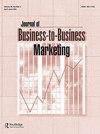转介是一把双刃剑:转介效应的相关理论
IF 2.5
4区 管理学
Q3 BUSINESS
引用次数: 1
摘要
摘要目的探讨全面正向推荐在B对B营销中产生多重效应的内在机制。方法论/方法作者进行了2次初步探索。从业者注1分析了ERV和IB对转诊效果的影响。从业者注2分析了他们之间的互动对转诊效果的影响。这些数据来自对来自中国40家生鲜连锁超市的112名采购人员的问卷调查。结果有效转诊值(ERV)低于一定水平的转诊更有可能产生负面影响,反之亦然。边界条件取决于潜在客户对推荐供应商综合绩效水平的初始信念(IB)。作者将这种机制称为推荐效应的相关理论。研究启示首先,这篇从业者笔记对WOM和转介效应相关的研究文献做出了理论贡献。这是第一篇将IB引入转诊多重效应分析框架的文献,也是第一篇从ERV和IB的相对水平揭示多重效应机制的文献。Rocklage和Fazio(2020)分析了积极情绪在积极口碑中因产品类别而产生负面影响的机制,但需要注意的是,自变量是积极情绪,而不是积极信息内容本身。从这个意义上说,这篇从业者笔记首次分析了积极信息的负面影响,丰富了与口碑相关的文献。实践启示本从业者说明的初步发现对市场营销实践具有指导意义。推荐人不太可能对高声誉供应商产生积极影响。对于中低信誉水平的供应商来说,推荐人是一把双刃剑。因此,不建议高信誉供应商实施供应商选择推荐计划,中低信誉供应商在选择推荐人时应谨慎,因为推荐人可能会产生负面影响。原创性/价值/贡献作者通过构建包括ERV和IB在内的多重效应分析框架来弥补现有研究中的这一不足,从而促进了WOM和转介效应相关研究理论的发展。本文章由计算机程序翻译,如有差异,请以英文原文为准。
Referrals are A Double-Edged Sword: A Relative Theory of Referral Effects
ABSTRACT Purpose To investigate the internal mechanism by which comprehensive positive referrals in B to B marketing generate multiple effects. Methodology/Approach Author conducted 2 preliminary explorations. Practitioner note 1 analyzed the influence of ERV and IB on referral effect. Practitioner note 2 analyzed the influence of the interaction between them on referral effect. The data came from a questionnaire survey of 112 purchasing staffers from 40 fresh food supermarket chains operating in China. Findings Referrals whose effective referral value (ERV) is lower than a certain level are more likely to produce negative effect, and vice versa. The boundary condition depends on the initial belief (IB) of potential customers on the comprehensive performance level of the referred suppliers. The author calls this mechanism the relative theory of referral effect. Research Implications First, this practitioner note makes a theoretical contribution to the research literature related to WOM and referral effect. This is the first literature to introduce IB into the referral multiple effects analysis framework, and the first to reveal the mechanism of multiple effects from the perspective of the relative level of ERV and IB. Second, this paper contributes to the research on WOM. Rocklage and Fazio (2020) analyzed the mechanism of negative effects of positive emotions in positive WOM (PWOM) due to product categories, but it should be noted that the independent variable was positive emotions rather than the positive information content itself. In this sense, this practitioner note is the first to analyze the negative effects of positive information, which enriches the literature related to WOM. Practical Implications the preliminary findings of this practitioner note have guiding significance for marketing practice. That it is unlikely that the referrer will have a positive impact on high-reputation suppliers. For suppliers with low and medium reputation levels, the referrer is a double-edged sword. Therefore, it is not recommended that high-reputation suppliers implement supplier-selected-referral programs, and low and medium-reputation suppliers should be cautious in selecting referrers, for the referrer may have negative effects. Originality/Value/Contribution The author makes up for this deficiency in the existing research by building a multiple effect analysis framework including ERV and IB, thus promoting the development of research theory related to WOM and referral effects.
求助全文
通过发布文献求助,成功后即可免费获取论文全文。
去求助
来源期刊
CiteScore
2.20
自引率
35.70%
发文量
22
期刊介绍:
The Journal of Business-to-Business Marketing® encourages diversity in approaches to business marketing theory development, research methods, and managerial problem solving. An editorial board comprised of outstanding, internationally recognized scholars and practitioners ensures that the journal maintains impeccable standards of relevance and rigorous scholarship. The Journal of Business-to-Business Marketing features: •basic and applied research that reflects current business marketing theory, methodology, and practice •articles from leading researchers covering topics of mutual interest for the business and academic communities

 求助内容:
求助内容: 应助结果提醒方式:
应助结果提醒方式:


